The various fungi on human feet are called mycos. When the skin is affected, the disease refers to the group of dermatomycosis (epidermophytosis, trichophytosis) because the dermis is translated into Greek as skin. If the nail is affected, the disease is defined as onychomycosis.

Causes of the disease
Fungus on the feet is a common disease that occurs all over the world. It is more common in cities than in rural areas. Athletes, showers and gay shop workers are at risk for foot fungus infection. Children have thinner skin that is not protected from external factors and are therefore also susceptible to mycosis. Another cause is increased sweating of the feet due to diseases of the body or congenital traits. Dermatologists believe that the risk of foot fungal infection increases with age. Factors contributing to the disease:
- wearing closed uncomfortable imitation leather shoes;
- a warm humid environment when wearing typical shoes;
- violation of the blood supply to the limbs;
- frequent visits to crowded places;
- weak or malfunctioning immune system;
- wearing foreign shoes.
Rapid infection
Leg dermatomycosis in public areas can easily spread from a sick person to a healthy person. Infection occurs through contact surfaces: floors, household items, personal hygiene items, someone else’s shoes. The fungus spreads through direct contact, multiplies very quickly, which is why it is so easy to become infected. The situation of fungal infection of the fungus in the barbershop through tools under the pedicure as well as towels is not excluded. The disease affects the skin of the feet. It is especially common in men as they spend most of their time in closed shoes. Frequent visits to gyms, spas, military service, where you don’t always have to wear your own shoe size - all this creates favorable conditions for the growth of pathogenic bacteria. An unventilated area of the room is useful for disease-causing fungi to reproduce. The spread of the pathogenic flora is very fast. The predominant site of the fungus is the toes and interdigital spaces. Saunas and baths are characterized by high humidity and high temperature, which is ideal for the development of pathogenic microflora.
Fungal infection can be direct or indirect. It can become directly infected through direct contact with a sick person. Indirect pollution means the use of objects used by a sick person.
Manifestations of mycoses
The very first symptom of the disease is the appearance of scales on the skin in the area of the foot. Through these elements, infection occurs. Increased sweating is a favorable factor in the growth of microbes as the altered composition of sweat becomes a nutrient for the growth of the pathogenic flora.
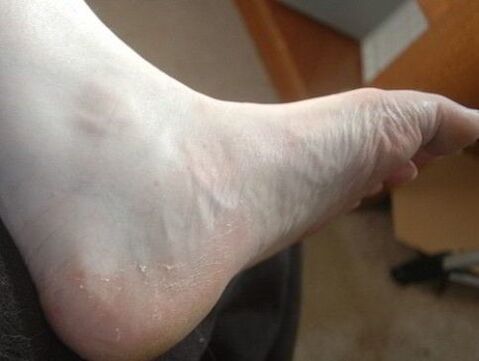
Dirt and fiber residue from socks also collects between the toes. If a fungal infection is added to the factors listed, redness occurs there. The affected area begins to itch unbearably, causing discomfort to the person. The skin begins to peel, causing painful cracks to appear. While walking, there are unpleasant painful feelings due to the presence of sores on the skin of the foot. The skin begins to thicken and the infection can spread to the nails. If left untreated, mycosis spreads and affects the nails, destroying them. The nail plate first changes color to white. It may peel off afterwards. Cavities are formed between the nail plate and the nail bed. In the case of mushrooms on the feet, an unpleasant odor appears. In winter, when wearing closed shoes, the foot is not ventilated, the intensity of the changes in the feet increases. The treatment of this pathology requires an accurate diagnosis because there are many types of fungal pathogens.
The main types of the disease
- The membrane type (intertriginous form) is the most common. Fungal infection is observed between the fifth and fourth toes. Gradually, the skin acquires a scaly structure with elements of cracks. Sometimes a bacterial infection is linked to the fungus, causing even more damage to the skin of the feet.
- Moccasin-like type. Manifest pain in the leg. The skin then thickens, thickens and cracks. Severe fungal lesions seize the nails, which can begin to crumble over time.
- Vesicular type (dyshydrotic form). Manifestation of blisters under the skin, filled with fluid. It is often associated with a bacterial infection.
Types of mushrooms on the legs with a photo name
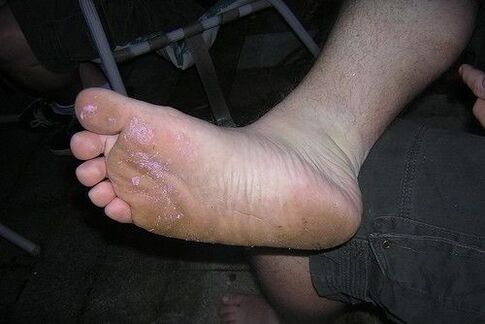
There are different types of fungi that correspond to different diseases. There are four most common types of fungi that damage the legs.
- Trichophyton rubrum (Trichophytonrubrum) is fraught with rubrophytosis.
- Trichophyton interdigitale (Trichophytoninterdigitale) affects the skin between the fingers, covering the entire leg of the disease. It causes epidermophytosis.
- Trichophyton mentagrophytes leads to complete epidermophytosis.
- Female fungus Candida albicans. It causes candidiasis of the foot, but it is rare.
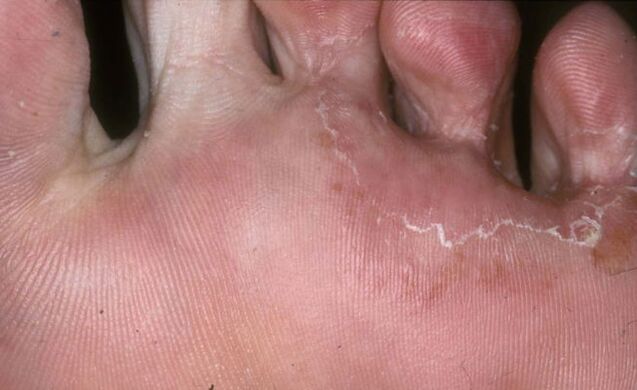
Epidermophytosis and trichophytosis (rubromycosis) is a skin disease that is collectively referred to as foot mycosis, caused by parasitic fungi of the genus Dermatophytes.
Classification
Dermatophyte fungi:
- microsporum;
- epidermophyton;
- t.
Molds causing fungal diseases:
- hendersonula;
- altemaria;
- s.
Yeast pathogenic fungi:
- pityrosporum;
- candida;
- cryptococcus;
- malassezia;
- coccidoids;
- histoplasma;
- w.
Preventive measures
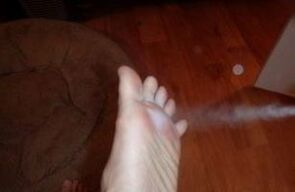
Because fungi love warm, humid habitats, this means we have to violate these conditions to get rid of them. Therefore, to prevent fungus, the feet should be clean and dry. It is important to change your socks in time and dry your shoes. Special antiperspirants are available that block the development of the pathogenic microflora. To maintain normal metabolic processes between the feet and the environment, it is better to choose leather shoes. The feet sweat less and the fungi do not have the conditions to reproduce. At home, it is advisable to wear socks that you take off and wash while microbes and dirt accumulate in your home shoes.
You only have to use your own things as you do not know the presence of other diseases. Your immunity may not be able to cope with pathogens and become infected. You need to ventilate your shoes more often. It is advisable to bring personal hygiene items when visiting public places. Never walk barefoot on the floor in swimming pools and showers. The use of prophylactic antifungal creams and ointments also helps. After all, swimming pools, changing rooms, saunas and other high-humidity rooms are areas where mushrooms grow. At home in the bathroom is better to refuse porous carpets.
Risk group
There are people who are more prone to this disease than others. This can be caused by body problems such as:
- overweight;
- violation of blood circulation in the legs;
- flat legs and leg deformity;
- impaired immune system;
- stressed people;
- after antibiotic treatment.
Diagnosis of fungal disease of the foot
The doctor performs a detailed examination of the foot, asking for a complaint. Skin samples are taken from the patient to be fungal. They get a piece of skin with a small, specially made scratch on their leg. For analysis, the nail is cut from the site infected with the fungus. The presence of mycosis is determined by special tests. It is bred, i. e. grown, to identify the type of fungus. In rare cases, with an advanced stage of the disease, the patient may prescribe a biopsy. In this case, the prepared material is examined under a microscope.
Treatment methods
In order to achieve the results of the treatment, the type of fungus and the presence of infections, if any, should be clarified. The extent of the damage is also taken into account.
The basis of membrane-type treatment seems to be the application of antifungal drugs to the affected area. This is also convenient to do at home. These drugs stop the growth of bacteria or slow down the spread of the disease. Many of these drugs are available without a prescription. The substances act locally at the site of application on the affected skin. It is important to monitor the dynamics of your treatment, if there is no improvement, the medicine may not help you.
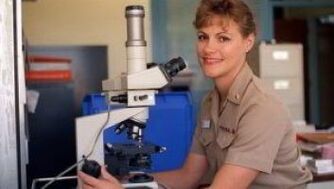
If the drug used does not affect, a dermatologist should be consulted again to prescribe another treatment. You may need to prescribe stronger medication. In particularly severe cases of the disease, tablets are prescribed. Many medicines have side effects, so your blood counts should be checked during treatment with the tablets. The fungus is very difficult to completely cure as it can recur. Treatment should not be stopped, otherwise the fungus may show resistance to the components of the medicine that affect them. The cleanliness and dryness of the feet should be checked during treatment. In the moccasin-like infectious form, onychomycosis, i. e. damage to the nails, occurs very often. Due to the fact that the skin of the foot has thickened and medications are harder to penetrate, this disease is harder to cure. In this case, the usual drugs "do not work" and prescribe additional therapy in the form of tablets. Onychomycosis - damage to the toenail of the foot with a fungus of the genus Dermatophytes. The disease can also be caused by yeast and mold. There are several types of onychomycosis:
- Distal subungual. Depending on the area of the nail plate lesion, three degrees of injury are distinguished. If the nail is indicated in one stage and is conditionally divided into three parts (in depth), then the volume of up to two-thirds of the lesion corresponds to the first two stages of the disease. And when the nail touches more than 2/3 of the fungus, it’s already the third grade. In this case, the root (matrix) of the nail is involved in the disease process, and sometimes the folds of skin on the side of the nail, called periungual spines;
- proximal subungual. Defeat of the back of the nail plate where the hole is;
- superficial white. This type of onychomycosis is common on the feet;
- complete dystrophy. The last concluding stage.
In the vesicular type, your doctor may order the top of the blisters to be removed. Then all the liquid is drained from them. This area is dried, applied with an antifungal cream or a special compress. If the presence of a bacterial infection is determined, a course of antibiotics is prescribed. Sometimes the disease is associated with fever. Acute infections respond better to treatment than chronic fungal and slow processes. In severe cases, hormonal drugs are prescribed. Antifungal medications are taken until complete recovery. Sometimes the fungus is not all killed and when the drugs are deleted, the disease relapses.
If the patient is not treated, the disease becomes chronic and a severe bacterial infection develops. In addition to the feet, the skin of the toes may also be affected by the disease.
Traditional medicine offers compresses and body lotions to treat nail fungi with tea tree oil, which has an anti-inflammatory effect, and garlic. Washing with standard detergents does not always kill pathogenic bacteria. To remove the fungus from the clothes, the bedding should be washed in hot water or, if possible, boiled. We recommend the use of bleach and hot ironing.
























